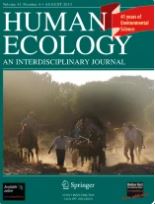Masks Versus Cattle: The Ecology of an African Art Form
 Masquerades form an important part of indigenous African religions, and headpieces of masks are found all over the world as an iconic African art form. Contrary to expectation, however, the geographical distribution of masking is very restricted, occurring only in three areas of the continent, mainly situated in the forested zones. I explain this peculiar distribution by tracing the ecological and historical parameters of the societies that harbor mask rituals. The main ecological factors are the absence of cattle and the type of horticulture, while a crucial historical element is the long history of slave raiding and trading to which the continent has been subjected. These factors have led to societies in which both gender and local power arrangements show a marked indeterminacy, operating as internal arenas between men and women, and between different groups of men. Crucial in the explanation of masquerades is the fact that masking is completely absent from societies that practice cattle husbandry with the Bos indicus species (zebu). Since sleeping sickness prohibits cattle husbandry, wherever the tsetse fly thrives, masks appear.
Masquerades form an important part of indigenous African religions, and headpieces of masks are found all over the world as an iconic African art form. Contrary to expectation, however, the geographical distribution of masking is very restricted, occurring only in three areas of the continent, mainly situated in the forested zones. I explain this peculiar distribution by tracing the ecological and historical parameters of the societies that harbor mask rituals. The main ecological factors are the absence of cattle and the type of horticulture, while a crucial historical element is the long history of slave raiding and trading to which the continent has been subjected. These factors have led to societies in which both gender and local power arrangements show a marked indeterminacy, operating as internal arenas between men and women, and between different groups of men. Crucial in the explanation of masquerades is the fact that masking is completely absent from societies that practice cattle husbandry with the Bos indicus species (zebu). Since sleeping sickness prohibits cattle husbandry, wherever the tsetse fly thrives, masks appear.
This article appeared in Human Ecology (2024). Berlin: Springer.
Author(s) / editor(s)
About the author(s) / editor(s)
 Wouter van Beek is a retired anthropologist whose main thematic interests are religion, cultural ecology and tourism. In 2007 Wouter became Professor of Anthropology of Religion at Tilburg University (part time), where he taught various courses till his emeritate in 2015. He is a regular teacher for the HOVO (Higher Education for Seniors) at the universities of Leiden, Utrecht and Tilburg, in a variety of lecture courses.
Wouter van Beek is a retired anthropologist whose main thematic interests are religion, cultural ecology and tourism. In 2007 Wouter became Professor of Anthropology of Religion at Tilburg University (part time), where he taught various courses till his emeritate in 2015. He is a regular teacher for the HOVO (Higher Education for Seniors) at the universities of Leiden, Utrecht and Tilburg, in a variety of lecture courses.

